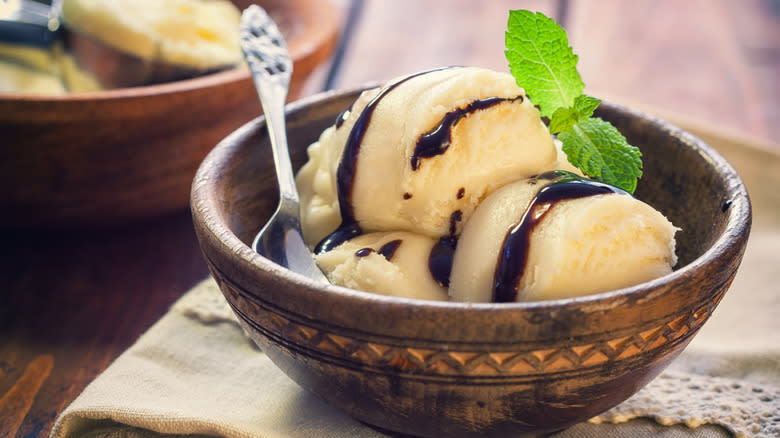Take Advantage Of Winter Weather With Ice Cream Made Of Snow

Snow is a staple of the festive season in many regions -- but typically as an ingredient for a snowman, not ice cream. While unorthodox, ice cream made from snow isn't as unusual as some might think, proving more delicious than divisive with dessert enthusiasts across the years. Snow ice cream has become popular thanks in part to its versatility, complementing an assortment of sugar, sauces, and sprinkles. Not only that, but the abundance of this natural ingredient during the winter makes it one of the more financially-friendly dishes to whip up for the holidays.
Ice cream might not sound as appetizing during the winter months as it does during the summer, but adding snow to the mix transforms this dish while creating a fun activity the whole family can enjoy. This wintry combination has a surprisingly long-standing history, with some of the oldest ice cream recipes containing natural snow as a prime ingredient.
All things considered, ice cream snow could be a new contender for Christmas dinner must-haves, as necessary as cranberries and turkey. The origins of this dish extend all the way back to the early days of humanity and it is still a popular seasonal staple in various parts of the world.
Read more: The Ultimate Ice Cream Brands, Ranked
Snowy Ice Cream Has Been A Popular Dessert For Years

As long as it's clean and safely sourced, snow is safe (and tasty) to eat, and has been eaten for millennia. As long ago as 400 B.C.E. in Persia, snow was mixed with grape juice concentrate for a light and refreshing dessert. Ice was made in large pits built inside huge conical structures known as yakhchāls during the winter, then preserved with wind and water so the nobles could enjoy the frozen dessert.
Today, ice cream made with snow (also sometimes referred to as snow cream) remains a popular dish in various parts of the world. Many in America's southern and Appalachian states consider this dish a traditional delicacy. Kentucky-born singer Loretta Lynn recalled fond childhood memories of gathering fresh snow for snow cream in her cookbook "You're Cookin' It Country." Snow-based ice cream is also a popular dish in Canada, as well as other global regions that see heavy snowfall regularly.
Quick, tasty, and easy to make at home, snow's fluffy texture makes it a lighter addition to ice cream, creating more of a velvety texture. The basic ingredients include freshly gathered snow, milk or condensed milk to hold it together, and sugar and vanilla to give it flavor. If you have a strong sweet tooth you can even add extra ingredients such as chocolate pieces, fruit, or nuts. Snow melts quickly, so just be sure to store your supply in the freezer.
If Snow Sounds Unappetizing, Try Shaved Ice Instead

For those not keen on the idea of gathering and eating snow, whether for contamination reasons or an aversion to rummaging in the cold, fear not -- shaved ice works just as well as fresh snow when it comes to making your own ice cream, given its similarly fluffy texture. Shaved ice and snow are essentially the same thing: flaky frozen water. With the right recipe, both can create creamy and smooth homemade ice cream that is fluffier than its snow-less counterparts and is exceptionally easy to make at home.
South Korean bingsu is a popular native dish that combines shaved ice with sweeteners such as fruit and honey. Like the Ancient Persians' snow ice cream, bingsu has an extensive history stretching back thousands of years, with the ancient locals gathering snow to create their own frozen desserts. The dish was brought to Korea during the Joseon Dynasty, where it is now a well-known sweet treat, commonly made from shaved ice topped with fruit, nuts, and syrups.
Snow and ice can be applied in an assortment of additional sorbets to sauces. Its quick and easy formula has made it a go-to sweet treat for countless years, with a plethora of new and exciting available recipes incorporating this natural resource into the modern home and popularizing an ancient tradition of humanity's winter kitchen.
Read the original article on Daily Meal.

